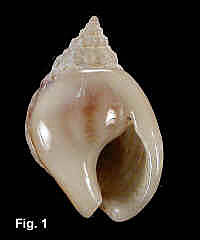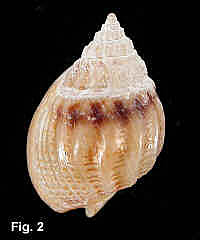

|
Nassarius
jonasii (Dunker,
1846)
Description:
Shell with rounded whorls with axial folds that form nodules at the
sutures, with a constriction below; folds on the dorsal surface of the
body whorl restricted to upper half of the whorl. Body whorl with widely
spaced spiral ribs on the base, extending to the centre of the whorl,
and sometimes with spiral grooves between the axial folds on the upper
half of the whorl. Outer lip reflected outwards, either smooth or with
8-10 teeth internally. Columella callus expanded, usually extending
above the body whorl; columella smooth. Columella callus white, exterior
fawn or brown, with a dark band below the suture.
Size:
Length up to 16 mm.
Distribution:
Endemic to Australia; Noosa Heads, Qld, to SA.
Habitat:
On sand and mud flats in estuaries and lagoons, intertidal down to 100
m. Abundant.
Comparison:
N. jonasii may be distinguished from N. burchardi by
several characters. In jonasii there is frequently spiral grooves
between the axial folds on the upper half of the body whorl, but they
are absent in burchardi. The callus is larger and thicker in jonasii
than in burchardi and usually extends beyond the body whorl,
while this is rarely so for burchardi. The most consistent
feature is that jonasi has a smooth columella, but teeth are
always present on the lower half, even if weak, in burchardi.
Synonyms:
Austronassaria simplex C. & J. Laseron, 1956; Nassa
mangelioides Reeve, 1853
Figs. 1,2: Tuross Head, NSW (DLB4960)
|